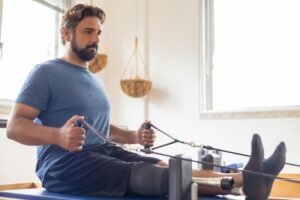 In the fitness arena, it is usually referred to in terms of how intense and for how long one must do cardiovascular exercise. On the flip side, one thing that is often overlooked is cardio recovery. Good recovery strategies can do wonders not only for performance but also to prevent injury and promote longevity in health. The complete guide to doing right by your body: how to recover from cardio safely and effectively so that you get the most out of all workouts.
In the fitness arena, it is usually referred to in terms of how intense and for how long one must do cardiovascular exercise. On the flip side, one thing that is often overlooked is cardio recovery. Good recovery strategies can do wonders not only for performance but also to prevent injury and promote longevity in health. The complete guide to doing right by your body: how to recover from cardio safely and effectively so that you get the most out of all workouts.
Understanding Cardio Recovery
What is Cardio Recovery?
What is Cardio Recovery? Cardio recovery encompasses all of the activity and structures that sustain body repair and modification after cardiovascular exercise. It is one of the most important stages in terms of repairing muscle, filling up energy reserves, and preventing overtraining. Recovery is generally classified into two main types: active recovery and passive recovery.
Active Recovery:
This entails performing low-intensity activities that help increase blood flow to the muscles, allowing them more time to recover without adding extra stress to your body. Examples are walking light jogging, and gentle cycling.
PASSIVE RECOVERY:
This means full rest or idle activity to let the body completely recover, especially if you have just done a hard workout or are feeling fatigued.
Why is Recovery Important?
This commodity is significant for a few reasons:
C. Muscle Repair:
High cardio workouts cause mini tears in muscles.s Top Subject specific Articles — ORTOPEDIAJacks Muscle Pain Recovery and SupercompensationMuscles suffer damage during training.
Restoration of Energy Levels:
Cardiovascular exercise uses up the glycogen stored in muscles, and these stores have to be replaced, especially for your next workout.
Injury prevention:
Without proper recovery, the risk of an overuse injury, increased fatigue, and burnout may rise, all factors that affect performance in a negative way.
Reduced Stress:
Recovery lowers stress and gets your head on straight, a key to staying motivated.
Best Practices in Cardio Recovery
1. Hydration

Hydrate: Recovery starts with proper hydration. If you set out on an intense cardio exercise session, excessive sweating and fluid loss can cause dehydration, which will impair muscle function and & recovery.
Best Practices:
Pre-Workout:
Stay hydrated, drink water (Be properly Hydrated before exercise)
During exercise:
If your workout lasts longer than 30 minutes, seek out some electrolyte-rich beverages.
Post-Workout:
Drink water or sports drinks to help fill up what you’ve lost. As a broad rule of thumb, aim for 16-24 ounces per pound lost in training.
Stay Aware:
Check the color of urine viz., Light yellow indicates good/well hydration, or if darker shades appear, then your body has decreased water.
2. Nutrition

Nutrition:
It is essential to receive proper nutrients after a workout, as your body needs them in order to recover. Replenish glycogen stores and increase protein synthesis.
Best Practices:
Carbohydrates:
Try to eat your meal containing carbohydrates like a snack or carbohydrate-rich food 30 minutes after you work out: bananas, whole-grain toast with peanut butter, or smoothies.
Protein:
Include functional protein to assist with repairing muscle; suggestions are Greek yogurt, lean meats (chicken/turkey), or supplementing this through a shake.
Proper Meals:
Be sure that your meals have carbs, protein, and healthy fats.
When to do it:
Eat one of these post-exercise recovery meals within 2 hours after your workout.
3. Active Recovery

What is Active Recovery? These low-intensity exercises can help circulation and recovery without causing more stress on the body.
Best Practices:
It can be anything as simple as walking, light jogging, ng, and even yoga!
When to Perform:
Use on your off days or cardiovascular workouts.
Length:
Active recovery sessions vary from 20 to 60 minutes long based on your training volume and tiredness.
4. Stretches/Flexibility Exercises

Benefits of Stretching Stretching keeps the muscles flexible, healthy, and strong,g which enables them to maintain a range of motion in joints when moving.… Unstretched or tight muscles are prone to tears (the most common sports injury).
Best Practices:
Dynamic Stretching:
Try dynamic stretches before your workout to get those muscles ready.
Cool Down:
After your cardio session, perform static stretches that focus on large muscle groups used during the workout.
Foam Rolling:
It helps in muscle tightness release and enhances blood circulation.
5. Sleep and Rest

The recovery tool:
Awaaz’s Role of Sleep in Recovery Quality Sleep is one the most effective means of recovering. Our bodies do all of their most critical repair processes during sleep.
Best Practices:
Sleep:
Aim for 7-9 quality hours a night of SLEEP.
A Standard Routine:
Try to have a routine before you go to sleep — just as young children do.
Create a Room of Slumber:
Keep your bedroom calm, dark,k and quiet.
3N — Pre-Sleep Routine = Do relax things before you go to bed (e.g., reading, light stretching)
6. Cold Therapy

What is Cold Therapy? Cryotherapy, also known as cold therapy, is an orthopedic treatment most commonly used to decrease inflammation and muscle pain.
Best Practices:
Soaking in Ice Baths — Try taking an ice bath after your workout to alleviate muscle soreness.
Cold Packs:
Apply cold packs to areas of soreness and inflammation.
Contrast Showers: Alternating hot and cold water in the shower can increase blood flow and decrease muscle soreness.
7. Compression Garments

How Compression Helps:
Wearing compression can aid circulation and lower inflammation after we work out.
Best Practices:
Type Of Garments:
Wear compression socks/sleeves during and after exercise.
Align:
Are you maximizing the benefits of a proper fit?
Use Time:
Wear a compression garment for a few hours after the workout.
8. Massage Therapy

Massage-Relieves muscle tension improves circulation and can be relaxing.
Best Practices:
Consistent Pop-ups: Set up repeated massage times, primarily focused on post-heavy training periods.
Self-Massage:
Use self-massages like Foam rolling onshore areas.
Post-Workout Massage:
Add a brief post-workout massage when available (it may help you really feel more kicked back and much less unable to attend).
9. Meditation, Relaxation gears

The role of mindfulness:
Stress management is important for recovery, as very high levels can inhibit successful efforts to recover.
Best Practices:
Mindfulness meditation:
Integrate a daily mindfulness meditation practice to improve mental recovery.
Breathing exercises:
Give yourself stress-slashing and calming deep-breath practice.
Yoga and Tai ChiFit yoga or tai chi into your routine
Some Tips To Improve Cardio Recovery
1. Listen to Your BodyCheck-in on your body after a workout. Otherwise, fatigue or excessive soreness may be telling you that, in which case an extra recovery session might help.
2. Plan Recovery Days
Implement recovery days into your workout route. Similarly, giving your body proper recovery time is crucial to exercise processing.
3. Monitor Intensity and Volume
Start slowly to avoid overtraining by increasing the intensity of your workouts progressively. Most people have heard the 10 % rule, which states that you should not increase your training load by more than 10% per week.
4. Use Technology
Arjun Rampal: Wearable technology can help monitor your heart rate, sleep pattern,s and recovery status. Use this information to tailor your recovery plans.
5. Stay Consistent
Then, the trick is to be consistent in applying these recovery practices. Stay hydrated, eat nourishing food, and recover actively as part of your daily routine.
6. Mix Up Your Workouts
To prevent burnout and overuse injuries, up your cardio workouts. In this way, you can create variety so that no individual training session bores one to death.
7. Set Realistic Goals
Training tip #1: Set fitness goals appropriate to your recovery. Realize that some progressions may differ, and adjust your training plan accordingly.
8. Educate Yourself
Learn about the new science of exercise and recovery.Knowledge gives you the power to think before choosing it!
Sample Weekly Recovery Plan

Below, I make a simple weekly recovery plan for one who does regular cardio workouts to demonstrate how you could apply these rescue techniques.
Monday: High-Intensity Cardio
Exercise: 60 mins HIIT ( High-Intensity Interval Training)
Post-Workout Recovery:
Usual care: Fluid and electrolyte replacement.
Nutrition: Eat a high carbohydrate, protein meal
Static Stretching: Hit significant muscle groups and stretch them.
Tuesday: Active Recovery
Activity: 30 minutes of light cycling or walking.
Post-Activity Recovery:
Water Intake: Keep sipping on water all day long.
Foam Rollin Roll output tight spots.
Time to Relax: 10 Minutes of Mindfulness Meditation
Wed: Mild Cardio session
Running: 45-minute run at moderate pace
Post-Workout Recovery:
Stay Hydrated – Drink Water, with or without electrolytes.
Proper diet (meal within 2 hours of exercise)
Compression: Put on compression socks for the remainder of the day.
Thursday: Rest Day
Engage in Pinterest and light activities like yoga.
Recovery Techniques:
Sleep: Aim for 7-9 quality hours of sleep
Wind down by doing something that relaxes you.
Friday: Long Cardio Session
Workout: 90 min steady state run or cycle
Post-Workout Recovery:
Re-Hydration: Replace the fluids which have been lost
Food: Eat a high-carb snack followed by the rest of your meal.
Cold Therapy for those sore muscles: Think as extreme as an ice bath or just some cold packs when necessary.
Saturday: Active Recovery
Pic: Get 30–45 minutes of swimming or easy hiking.
Post-Activity Recovery:
Drink: Keep Hydrating
Stretching: Gentle yoga and flexibility exercises. After the workout, a foam roller will be used to tackle any sore spots.
Sunday: Rest and Reflection
Undertake things that are not stressful. Take Stock of Your Workouts & Recovery from the We.ek
Recovery Techniques:
Map out your week ahead, making sure you have a good mix of training and downtime.
Conclusion
To sum up, tools for cardio recovery are critical in improving performance and preventing potential injuries while the rest of your health thrives. Adding in some hydration, good nutrition, working out (not junk food), and things like active recovery and flexibility work can help you make sure your body is primed for the next round of workouts.
Focusing on recovery feeds your physical health and pushes you towards mental clarity, which helps with motivation. Having a well-recovered body is critical to getting the most out of your fitness routine. Adopt these techniques, listen to your bo, and reap the benefits of a quality cardio recovery routine. If you are committed to recovery, the sky is truly the limit, and your fitness journey will be a happy one.


